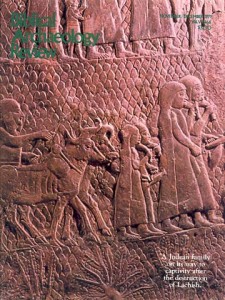Biblical Archaeology Review, November/December 1979
Features
Answers at Lachish
Sennacherib’s destruction of Lachish identified; dispute over a century’s difference in Israelite pottery dating resolved by new excavations; stamp impressions of Judean kings finally dated.
Lachish was one of the most important cities of the Biblical era in the Holy Land. The impressive mound, named Tel Lachish in Hebrew or Tell ed-Duweir in Arabic, is situated about 25 miles southwest of Jerusalem in the Judean hills. Once a thriving, fortified city, the...Read more ›
Crosses in the Dead Sea Scrolls: A Waystation on the Road to the Christian Cross
The relationship of the Dead Sea Scrolls to early Christianity has absorbed scholars since the dramatic discovery more than 30 years ago. Early, exaggerated commentaries which, for example, stated that the Teacher of Righteousness was Jesus of Nazareth1 or that Jesus was a veritable “reincarnation” of the...Read more ›
“Do You Know When the Ibexes Give Birth?”
The Hebrew word ya-el appears three times in the Bible. In English translations it is usually translated as “wild goat,” and in some modern translations, as “mountain-goat.” In actuality, the Hebrew ya-el is the ibex (Capra ibex nubiana), one of the loveliest and most agile members of...Read more ›
Ebla Evidence Evaporates
Smithsonian expert guesses Ebla tablets will support historicity of Patriarchal narratives, but we won’t know for decades.
One of the most direct links between the Ebla tablets and the Bible is the reported reference in the Ebla tablets to the five Cities of the Plain listed in Genesis 14. According to Professor David Noel Freedman of the University of Michigan, Vice...Read more ›
BAR Excavation in Jerusalem Highlights Summer Seminar
Digs uncover exciting Byzantine and Israelite relics.
The following report was prepared by Jim (Yaakov) Fleming, BAR’s Jerusalem correspondent and Director of BAR’s Summer Seminar in Israel. The first BAR-sponsored excavations took place last summer—appropriately enough—in Jerusalem. Not only did BAR members supply some of the funds to support the excavations, but much of...Read more ›
Reader Inspects BAR Restoration of an Israelite Village
The early Israelite site of Izbet Sartah, believed to be Biblical Ebenezer (1 Samuel 4), is inauspiciously located in the midst of the town dump of modern day Rosh Haayin. I went to Izbet Sartah to see the recently completed preservation work. (See “BAR...Read more ›

